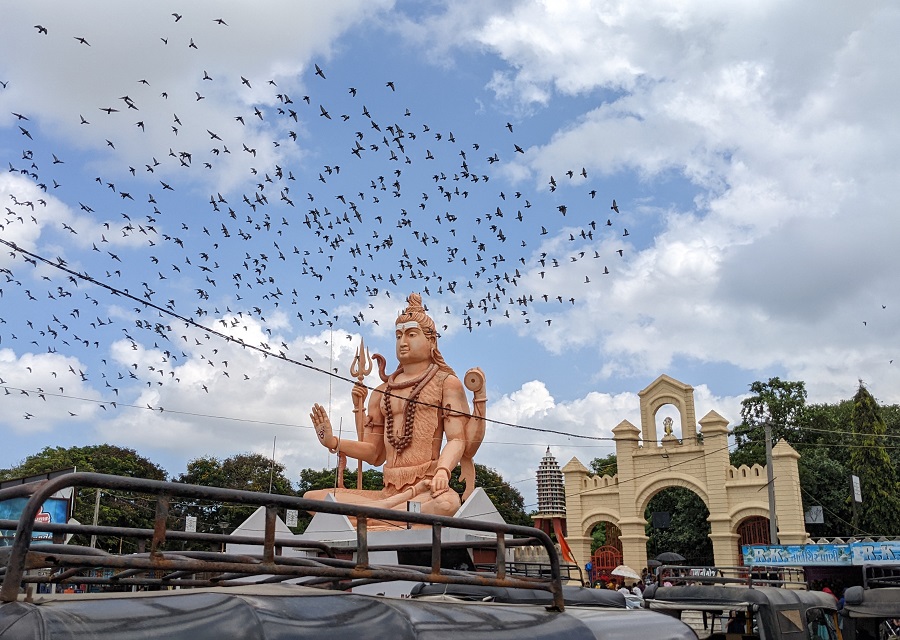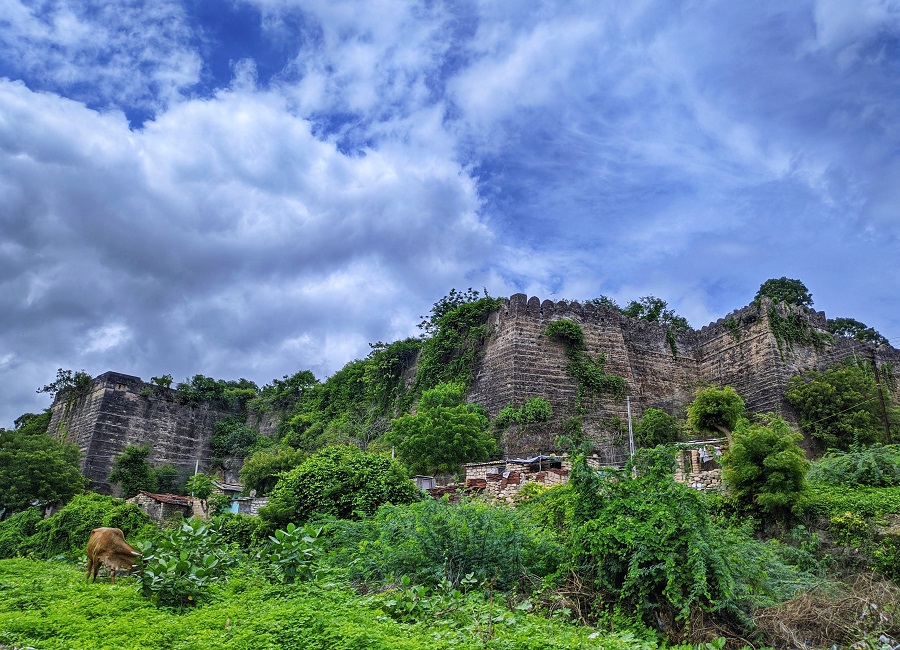Exploration of a land remains superficial if one just traverses its geographic contours and doesn’t concern with the hues of history intricately interwoven into the very existence of everyday life of its people and culture. That is why we take particular heed in ensuring that the tours we lead into the colourful land of Gujarat let you be acquainted with the historical backdrop of its tourist attractions as well. Talking of history, how can we not mention that Lothal and Dholavira in Gujarat still carry remnants of the 4000-year-old Harappan Civilization?
The historical narratives accompanying the major pilgrimage destinations in Gujarat add to their splendor and glory. Be it the Dwarkadhish Temple which prides itself on having been built over the hari-graha of what once had been Lord Krishna’s palace. The Char Dham pilgrimage dating back to the era of Adi Shankaracharya culminates with a visit to the same Dwarkadhish Temple. Archeological studies estimate the age of its main shrine to be 2000-2200 years. Even more ancient roots are traced of the Jyotirlinga at Somnath where Lord Shiva dwells in his beloved form of ‘Lord of Soma (Moon God)’. The temple towers high amidst the spectacular backdrop of ocean, in spite of having been through many cycles of destruction and subsequent restoration. The state bears one more pristine Jyotirlinga of Shiva at Nageshwara.
1. Dwarkadhish Temple
The Dwarkadhish Temple also known as the Jagat Mandir is a Chalukya-style Lord Krishna temple. Dwarka's history can be traced back to the Mahabharata's Dwaraka Kingdom. The five-story main shrine, constructed of limestone and sand, is magnificent in its own right. Vajranabha is thought to have built the 2200-year-old architecture on land reclaimed from the sea by Lord Krishna. The temple features intricate sculptural detailing done by the region's ancestral dynasties, as well as a magnificent black idol of Lord Krishna.
2. Lothal
If you are a history buff who is interested in the lives of previous generations, you must visit Lothal because it is a place that bridges the gap between the past and the present. Lothal is a popular Indus Valley Site and a 4500-year-old city discovered in 1954 on the banks of the ancient mythical river Saraswati, about 85 kilometres from Ahmedabad (which has now dried up). Even though the area is no longer as vibrant as it once was, the magic of the ruins tells the colourful stories of the people who once lived here. Lothal, like other Indus Valley Civilization cities, had excellent architecture and city planning.
3. Adalaj Stepwell
It is a magnificent structure that was brilliantly constructed to alleviate the water crisis in and around Adalaj Village. The stepwell is located about 3 to 4 kilometres south-west of Gandhinagar, Gujarat's capital city. The Adalaj Stepwell, built in 1498, is one of many stepwells built in India to provide groundwater access. The entire structure is an excellent example of India's engineers' and architects' intelligence even at the time. The Vav is a magnificent piece of Indo-Islamic architecture and design. The flower motifs and graphics of Islamic architecture blend beautifully with the Hindu and Jain god symbols carved at various levels of the well.
4. Dholavira
Dholavira was one of the most developed cities around 4500 years ago and is known as a remarkable Indus Valley Civilization excavation site. It was a thriving Harappan settlement between 2650 and 1450 BCE. The village is now an archaeological site in Khadirbet, Gujarat, and is also known as Kotada Timba among the locals. The site contains visible pieces of architecture as well as the Harappan lifestyle. The town was divided into three main architectural layouts, with a large open stadium in the middle. Many artefacts were discovered, including earthen pots, beads, jewellery, and other materials. Dholavira had an excellent water-saving system. Two of its most important waterways were the Mansar and the Manhar.
5. Somnath Temple
The Somnath Jyotirlinga Temple is Lord Shiva's first of twelve Jyotirlinga shrines. It is one of the oldest temples in the country and is located on Gujarat's western coast. It is mentioned in ancient texts such as the Shrimad Bhagwat Geeta, Skandpuran, Shivpuran, and Rig-Veda, indicating its importance as a major pilgrimage site. The temple is located on the ancient Triveni Sangam, or the confluence of three rivers: the Kapila, the Hiran, and the Saraswati. The temple is known as an eternal shrine due to its tenacity in the face of time. It is said that emperors such as Mahmud Ghazni, Alauddin Khilji, and Aurangzeb looted and destroyed the temple seventeen times, but it still stands today.
6. Nageshwar Temple
This temple is one of India's 12 Jyotirlingas and is located in Dwarka. It is located on the Gujarat coast of Saurashtra, between Gomati Dwarka and Bait Dwarka Island. Lord Shiva, also known as Nageshwar Mahadev, is the main deity here, and the temple is also known as Nagnath Temple. Those who pray at the Nageshwar Jyotirlinga, according to the Shiva Purana, become liberated of all poisons, snake bites, and worldly attractions. The statue or Linga here faces south, as opposed to other Nageshwar Temples. The massive 80-foot-tall Lord Shiva statue is a major draw at Nageshwar Temple. Traditional Hindu architecture distinguishes the temple. Dwarka stone is used to create the Nageshwar Shiva Linga.
7. Jhulta Minar
The Jhuta Minar is one of the world's most intriguing architectural wonders. They remain unsolved mysteries to this day. The minarets are distinguished by the fact that when one is shaken, the other follows suit within a few seconds, whereas the connecting passage transmits no movements or vibrations. Many architects and historians have attempted to comprehend the physics and logic underlying the disparate movements of the minarets. These movements influenced the design of Jhulta Minar, which translates to swinging minaret. The 500-year-old structure is located in Ahmedabad's Sakar Bazar district. It was once a part of the Sidi Bashir Mosque, which was destroyed during a war between the Gujarat Sultanate.
8. Uperkot Fort
Uperkot is the upper citadel in Junagadh's eastern outskirts. Inside the walls of this over 2300-year-old fortress with walls up to 20 metres high in some places, there used to be a 300-foot-deep moat. that was reportedly inhabited by crocodiles for the protection of the fort. The two main tourist attractions in the fort are Neelam and Manek, which were forged in Cairo and brought by the Turks. Visit the fort complex's stepwells and caves as well. This historic site has step wells and caves, and the Turks brought the iconic attractions, the Neelam and Manek. It is, indeed, one of the most well-known historical sites.
9. Aina Mahal
In the mid-eighteenth century, the Aaina Mahal palace, also known as the 'Hall of Mirrors,' was built. Lakhpatji's flamboyant reign. Ram Singh Malam, a genius of an artist who studied in Europe for 17 years before returning to India in search of name and fame, was given responsibility for engineering, architecture, and embellishment. The king commissioned him to construct his dream palace, and thus the Aina Mahal was born. Outside the palace, explore the rest of the compound, which features beautiful carved doorways, elaborate window boxes, and balconies. The Aina Mahal is easily accessible from most of Bhuj and is located in the northeast corner of Hamirsar Lake.
10. Diu Fort
The Portuguese built Fort Diu on India's western coast during their colonial rule, and it is now administered by the Indian government. The fort-castle, known in Portuguese as 'Praça de Diu,' is located at the mouth of the Gulf of Khambhat on Gujarat's southern tip. The climbable lighthouse leads to the island's highest point and offers a spectacular view of the surroundings. Cannonballs cover the entire area, and cannons abound on the parapet. A, During Portugal's colonial rule, the Diu fort was named one of the seven wonders of the world.
Gujarat's historical sites have had an impact on the city's culture today. Visiting these places is like travelling back in time and getting a glimpse into the lives of Gujarat's current residents. Book yourself and your family the best Gujarat Tour Packages and be a part of the magnificent history.















